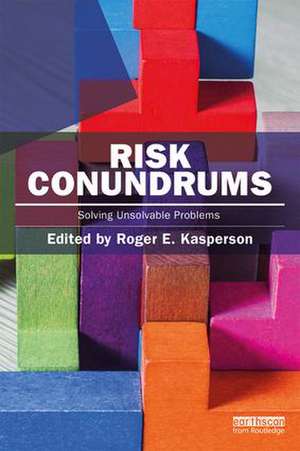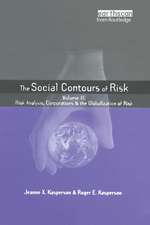Risk Conundrums: Solving Unsolvable Problems: Earthscan Risk in Society
Editat de Roger E Kaspersonen Limba Engleză Paperback – 13 iun 2017
Risk Conundrums seeks to answer this question by bringing together a range of key thinkers in the field to explore key issues such as risk communication, uncertainty, social trust, indicators and metrics, and risk management, drawing upon case study examples including natural disasters, terrorism, and energy transitions. The initial chapters address risk conundrums, their properties, and the challenges they pose. The book then turns to a greater emphasis on systemic and regional risk conundrums. Finally, it considers how risk management can be changed to address these unsolvable conundrums. Alternative pathways are defined and scrutinized and predictions for future developments set out.
This book will be of great interest to students and scholars of risk governance, environmental policy, and sustainable development.
| Toate formatele și edițiile | Preț | Express |
|---|---|---|
| Paperback (1) | 416.09 lei 6-8 săpt. | |
| Taylor & Francis – 13 iun 2017 | 416.09 lei 6-8 săpt. | |
| Hardback (1) | 1005.17 lei 6-8 săpt. | |
| Taylor & Francis – 13 iun 2017 | 1005.17 lei 6-8 săpt. |
Din seria Earthscan Risk in Society
-
 Preț: 317.61 lei
Preț: 317.61 lei -
 Preț: 346.17 lei
Preț: 346.17 lei -
 Preț: 310.31 lei
Preț: 310.31 lei -
 Preț: 372.90 lei
Preț: 372.90 lei -
 Preț: 300.41 lei
Preț: 300.41 lei - 12%
 Preț: 325.84 lei
Preț: 325.84 lei -
 Preț: 376.70 lei
Preț: 376.70 lei - 14%
 Preț: 329.14 lei
Preț: 329.14 lei - 16%
 Preț: 274.06 lei
Preț: 274.06 lei -
 Preț: 410.46 lei
Preț: 410.46 lei -
 Preț: 451.16 lei
Preț: 451.16 lei - 22%
 Preț: 323.32 lei
Preț: 323.32 lei -
 Preț: 416.22 lei
Preț: 416.22 lei -
 Preț: 347.80 lei
Preț: 347.80 lei - 17%
 Preț: 258.30 lei
Preț: 258.30 lei -
 Preț: 197.69 lei
Preț: 197.69 lei - 15%
 Preț: 705.64 lei
Preț: 705.64 lei - 15%
 Preț: 431.25 lei
Preț: 431.25 lei - 18%
 Preț: 1119.52 lei
Preț: 1119.52 lei -
 Preț: 497.92 lei
Preț: 497.92 lei - 18%
 Preț: 1008.48 lei
Preț: 1008.48 lei -
 Preț: 448.38 lei
Preț: 448.38 lei - 15%
 Preț: 435.36 lei
Preț: 435.36 lei -
 Preț: 416.22 lei
Preț: 416.22 lei - 18%
 Preț: 1003.12 lei
Preț: 1003.12 lei -
 Preț: 409.48 lei
Preț: 409.48 lei - 25%
 Preț: 683.99 lei
Preț: 683.99 lei -
 Preț: 451.36 lei
Preț: 451.36 lei -
 Preț: 391.34 lei
Preț: 391.34 lei - 26%
 Preț: 765.45 lei
Preț: 765.45 lei -
 Preț: 448.86 lei
Preț: 448.86 lei
Preț: 416.09 lei
Nou
Puncte Express: 624
Preț estimativ în valută:
79.62€ • 83.13$ • 65.89£
79.62€ • 83.13$ • 65.89£
Carte tipărită la comandă
Livrare economică 05-19 aprilie
Preluare comenzi: 021 569.72.76
Specificații
ISBN-13: 9781138956070
ISBN-10: 1138956074
Pagini: 298
Ilustrații: 49
Dimensiuni: 156 x 234 x 24 mm
Greutate: 0.45 kg
Ediția:1
Editura: Taylor & Francis
Colecția Routledge
Seria Earthscan Risk in Society
Locul publicării:Oxford, United Kingdom
ISBN-10: 1138956074
Pagini: 298
Ilustrații: 49
Dimensiuni: 156 x 234 x 24 mm
Greutate: 0.45 kg
Ediția:1
Editura: Taylor & Francis
Colecția Routledge
Seria Earthscan Risk in Society
Locul publicării:Oxford, United Kingdom
Public țintă
PostgraduateCuprins
Preface
Introduction
Introduction
- How Can We Be Sure That We Are Working on the Right Risks?
- Whose Views Really Matter in the End?
- How Do We Move Forward When There Is No Trust?
- How Can We Best Deal with the Unexpected?
- How Can We Learn More from Learning about Risk Controversies?
- The Role of Insurance and Other Policy Tools in Reducing the Economic Effects of Global Disasters
- How Can We Improve Decision Making in the Face of Catastrophic Risk?
- Risk Communication and Social Media
- China’s Development and Environmental Risk Management: A Balanced Perspective for the Future
- Addressing Risk Conundrums in Megacity Development: Mexico City
- Ambiguity in an Ambiguous Region
- Risk Conundrums of the Renewable Energy Transition: Can We Balance Opportunities, Optimism, and Challenges?
- Hydraulic Fracturing – A Risk for Environment, Energy Security and Affordability?
- Out of Harm’s Way: Challenges in Reducing Current and Future Coastal Risk Exposure
- Addressing Risk Conundrums in Sustainable Development
- Vulnerability does not just fall from the Sky: Addressing the Vulnerability Conundrum
- Risk Governance: Concept and Application to Systemic Risk
- How Can We Prevent the Collapse of Humanitarian Values in Foreign Policy Decisions?
Notă biografică
Roger E. Kasperson is Research Professor and Distinguished Scientist at the George Perkins Marsh Institute at Clark University, USA.
Descriere
Risk Conundrums brings together a range of key thinkers in the field to explore key issues such as risk communication, indicators and metrics, and risk management, drawing upon case study examples including natural disasters, terrorism and energy transitions. Part I addresses risk conundrums, their properties, and the challenges they pose. In part II, the book turns to a greater emphasis on systematic and regional risk conundrums. Part III considers how risk management can be changed to address these unsolvable conundrums. Alternative pathways are defined and scrutinized and predictions for future developments set out.



























